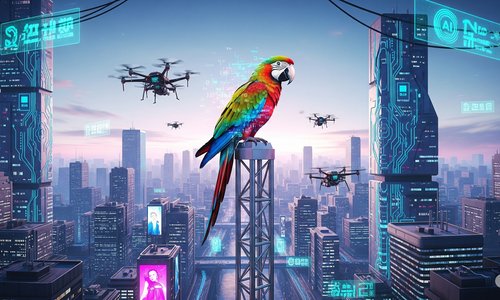
A Promessa e o Perigo da Nova Revolução Digital
A nova corrida tecnológica global levanta uma pergunta urgente: estamos prontos para confiar na inteligência que criamos?

Não apenas empresas privadas e governos nacionais mas também entidades internacionais tem se manifestado a respeito desta tecnologia. Aliás, embora seja tecnologia digital por excelência, seus usos mais relevantes dizem respeito à inovação em modelos de negócios!
Na Indústria 4.0 seus usos mais relevantes dizem respeito às cadeias produtivas e de abastecimento, também tratando de temas como identidade digital, automação de decisões etc.
Definição de Blockchain
Tecnicamente é banco de dados que mantém um livro-razão distribuído e que pode ser inspecionado de modo aberto pelos participantes do sistema/negócio.
Como Negócio é uma rede para movimentação de transações entre os participantes, movimentando ativos tangíveis, intangíveis e digitais entre “peers” (sistema ponto a ponto), sem a assistência de um elemento centralizador ou de um terceiro validador das transações.
Do ponto de vista da confiabilidade, as transações são criptografadas e validadas, seguindo regras de consenso.
Com a utilização da arquitetura BLOCKCHAIN é possível a criação de diferentes e inovativas aplicações.
A rastreabilidade e a imutabilidade são características essenciais do Blockchain. Uma vez efetuada a transação no bloco, não haverá mudança. Atualizações se dão por meio da criação de novas transações, as quais apontarão para a anterior e indicarão a atualização.
Com dados imutáveis, tem-se a garantia da integridade do dado e sua irretratabilidade.
Sendo ponto a ponto, Blockchain utiliza o conceito de computação distribuída, reduzindo custos e aumentando a velocidade dos processos (1).
Blockchain: Ecossistemas fechados
Blockchain surge em 2009 como suporte do BITCOIN, em redes abertas. Em 2014 é lançado o ETHEREUM, com o conceito de “smart contracts”, ampliando em muito o âmbito de utilização de Blockchain.
Multiplica-se a utilização de Blockchain em negócios específicos, como em cadeias de produção e abastecimento, identidade digital de documentos, prevenção à fraude em alimentos, finanças distribuídas etc.
Blockchain passa a ser utilizado como elemento integrador de dados e de lógicas entre diferentes participantes de um mesmo ecossistema.
Hyperledger, Linux Foundation.
Existem diversos fornecedores da arquitetura Blockchain.
Ainda em 2015 a Linux Foundtion lança um blockchain com código aberto, voltado a negócios. Em 2018 lança um documento explicativo do conjunto (2).
A IBM foi uma das primeiras empresas a se engajar no projeto, desenvolvendo uma versão do Hyperledger chamada Hyperledger Fabric, que inclui camadas específicas de segurança, possibilidade de uso em nuvens híbridas, uso em servidores específicos, camadas de automação de desenvolvimento de rotinas etc.
Blockchain na Indústria do Vinho
Um exemplo do ciclo dos processos que, partindo da uva, levam ao vinho apresenta as seguintes etapas (3):
A Produção da uva, a colheita, o desengace, o esmagamento, a primeira fermentação, a prensagem, a segunda fermentação, análises de lotes, colagem, maturação, filtração e engarrafamento.
A produção da uva necessita de controle de solo e de clima, da humidade do ar etc. Na colheita cuida-se dos fungos, composição de açúcares, ácidos etc. Na etapa do desengace trata-se da qualidade dos cachos; durante o esmagamento ´há necessidade de registro das técnicas utilizadas. Já na etapa da primeira fermentação há o registro sobre adição de enzimas, o controle e registro das temperaturas de fermentação etc. Durante o tempo da prensagem á o registro dos controles adequados, das técnicas utilizadas etc.
Mais à frente, já na etapa de maturação haverá o controle rigoroso de temperaturas, registros rotineiros etc. No engarrafamento haverá o controle do envelhecimento da garrafa, seus registros individuais, a rotulagem o controle do padrão das rolhas etc.
São Apenas algumas referências que tem como objetivo indicar o uso do Blockchain para registro imutável dos dados, permitindo ainda a atuação do sistema se automatizadas algumas funções, como no caso do controle das faixas de temperatura adequadas, disparando alarmes ou ligando / desligando equipamentos para que os limites de temperatura não escapem às tolerâncias permitidas.
Na ponta do consumo, após a ocorrência de todas as etapas de abastecimento do mercado, local ou internacional, teremos no Blockchain todo o registro e rastreamento da garrafa, desde a origem, passando por toda a produção, movimentação das garrafas até o destino final, seja no varejo, seja na casa do consumidor final, a depender do desenho do sistema de gestão e controle das cadeias de produção e de abastecimento.
Everledger – a primeira garrafa de vinho com registros garantidos por Blockchain
Consta que a primeira garrafa de vinho com registros garantidos por Blockchain foi um vinho Margaux 2001, certificado por Chai Wine Vault, com o uso de sistema da empresa Everledger utilizando o sistema Blockchain da Linux Foundation, Hyperlegder Fabric. Foram seguidas normas rígidas de controle, com o registro de mais de 90 itens relativos à produção do vinho (13). O QR Code da garrafa permitia o acesso aos dados registrados de modo imutável no ambiente Blockchain.
Blockchain na produção do chocolate
Os benefícios esperados de uma rede Blockchain implementada com sucesso permite aos usuários obterem os seguintes benefícios (4):
. Combate à fraude e a mercados paralelos;
. Rastreabilidade em tempo real;
. Proteção aos dados armazenados em livro-razão;
. Possibilidade de tornar os processos da cadeia de suprimentos mais eficientes;
. Possibilidade de comprovação do comportamento ético e ambiental das empresas;
. Melhoria da atividade de planejamento de reabastecimento;
. Criação de uma relação de fidelidade com os clientes.
Conforme dados da FAO, em 2016 os principais países produtores de cacsau eram:
Já a compra do cacau tinha como principais países Holanda, Estados Unidos da América, Malasia, Alemanha, Bélgica, França, Espanha, Itália, Turquias, Singapura etc.
Observa-se então uma circulação internacional do produto.
Na produção do chocolate há outra matéria prima essencial: o leite, que utiliza outros caminhos, desde a retirada do leite nas fazendas.
Estudo realizado em 2018 (5) mostra a seguinte cadeia de produção e abastecimento do chocolate:
Com o suporte da uma rede Blockchain é possível o controle da cadeia de produção do cacau (itens 5 e 7 - parte inferior do desenho) e também da cadeia de produção do leite (itens 5 e 6 - parte superior do desenho). Em determinado elo das cadeias, as matérias primas se encontram (item 4).
A partir deste ponto o processo segue produzindo o chocolate. Ao final, cada barra de chocolate recebe um QR Code que vai estampado na embalagem. Cada elo da cadeia, aponta para os elos seguintes, de acordo com o conceito de formação de blocos com registros em partidas dobradas. Há criptografia de cada registro que conterá os dados escolhidos pelos projetistas do sistema.
(*) Texto gerado a partir de aulas ministradas em novembro de 202, curso sobre a Indústria 4.0 – Universidade Rafaela, Argentina e Fundação Vanzolini, Brasil
REFERÊNCIAS BIBLIOGRÁFICAS
e-mail: antonio.limongi@hx8.com.br
http://lattes.cnpq.br/9469008438285343
www.linkedin.com/in/antonio-limongi
Consultor – Empresa LF1 Inovação
Parceiro de Negócios - IBM/INGRAM
Co-Criador da Criptomoeda ECOCHAIN Moeda Verde
Pesquisador e Professor - Grupos “Smart Cities” – Departamento de Engenharia de Produção – PRO/Poli/USP/F. Vanzolini e Gestão do Conhecimento/Redes de Cooperação – PRO/Poli/USP
Pós-doutor - Departamento de Engenharia de Produção–Poli/USP – Blockchain e Negócios de impacto social
Doutor em Inovação e em Estratégias Organizacionais - UNINOVE
Mestre em Direito Econômico – Mackenzie
MBA - Branding - FIRP/BRUNEL (UK)
Graduado em Direito (USP)
Graduado em Administração (S. Leopoldo, Santos)
Associado da I2AI, Grupo Inovação e IA
Membro da LACLIMA, Rede de Advogados pelo Clima
Membro da APROCORTE, Assoc. Produtores de Gado de Corte

A nova corrida tecnológica global levanta uma pergunta urgente: estamos prontos para confiar na inteligência que criamos?

Por que dominar a IA será a nova alfabetização do século XXI

Conselhos de Administração devem evoluir da supervisão reativa para a antecipação estratégica, frente à crescente complexidade e volatilidade dos ambientes de negócios.

De 14 a 25 de julho, reserve suas manhãs das 08h00 às 09h30 para participar da tradicional Maratona I2AI! Uma jornada intensa com debates e palestras sobre temas essenciais: Ética,